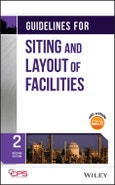This book has been written to address many of the developments since the 1st Edition which have improved how companies survey and select new sites, evaluate acquisitions, or expand their existing facilities. This book updates the appendices containing both the recommended separation distances and the checklists to help the teams obtain the information they need when locating the facility within a community, when arranging the processes within the facility, and when arranging the equipment within the process units.
Table of Contents
List of Figures xiii
List of Tables xvii
Acronyms and Abbreviations xix
Glossary xxi
Acknowledgments xxxiii
Foreword xxxv
Preface xxxvii
1 Introduction 1
1.1 Objectives 1
1.2 A Siting and Layout Approach 3
1.3 How to Use This Guideline 4
1.4 The Protection Layers 7
1.5 Terminology 12
1.6 Guideline References 15
1.7 Separation Distances Based Primarily on Fire Consequences 15
2 Overview of Benefits 17
2.1 Implications of Siting and Layout 17
2.2 Management of Risks 18
2.3 Implementing a Step-wise Approach for the Siting and LayOut of Facilities 23
2.4 Anticipating the Changing World 25
2.5 Summarizing the Business Case for Proper Siting of a Facility 25
3 Identifying the Process Hazards and Risks 27
3.1 Introduction 27
3.2 Describing the Facility’s Scope 28
3.3 Screening for Preliminary Hazards 29
3.4 Evaluating the Risks 40
3.5 Checklist for Identifying the Process Hazards and Risks 40
3.6 Summary 41
4 Selecting a Facility Location 42
4.1 Introduction 42
4.2 Additional Information on the Facility 43
4.3 Selecting a Team to Locate the Facility 43
4.4 Guidelines when Surveying Potential Facility Locations 46
4.5 Determining the Location Plot Size 47
4.6 Construction and Turnaround Issues 51
4.7 Maps and Information 52
4.8 Geological Issues 54
4.9 Weather Issues 59
4.10 Seismic Issues 62
4.11 Off-site Issues 62
4.12 Security Issues 65
4.13 Environmental Issues 67
4.14 Infrastructure Issues 74
4.15 Building and Structure Issues 74
4.16 Material Handling Issues 74
4.17 Communications Issues 83
4.18 Engineering Design Issues 85
4.19 Utilities Issues 88
4.20 Other Characteristics 94
4.21 Preparing the Information when Comparing Locations 96
4.22 A Siting and Layout Illustration 97
4.23 Checklist for Selecting a Facility Location 105
4.24 Summary 106
5 Selecting the Process Unit Layout within a Facility 107
5.1 Introduction 108
5.2 Block Layout Methodology Overview 110
5.3 How the Block Layout Integrates with the
Facility Location 118
5.4 Applying Preventive Measures when Arranging Process Units 118
5.5 Applying Mitigative Measures when Arranging Process Units 120
5.6 Construction and Turnarounds 123
5.7 The Block Layout Approach: Step 1 – Evaluating the Location’s Characteristics 128
5.8 Off-site Issues 131
5.9 Security Issues 134
5.10 Environmental Issues 134
5.11 Infrastructure Issues 134
5.12 The Block Layout Approach: Step 2 - Evaluating the Separation Distances between Blocks 135
5.13 Critical and Occupied Structures 139
5.14 Material Handling 155
5.15 Process Units 162
5.16 Tank Farms 165
5.17 Other Areas 169
5.18 Utilities 174
5.19 Optimizing the Locations of the Process Units 182
5.20 Resolving Block Layout Optimization Issues 184
5.21 Continuing the Siting and Layout Illustration 185
5.22 Checklist for Selecting the Layout of Process Units within a Facility 190
5.23 Summary 191
6 Selecting the Equipment Layout within a Process Unit 193
6.1 Introduction 193
6.2 Equipment Layout Methodology Overview 194
6.3 How the Equipment Layout Integrates with the Block Layout 198
6.4 Applying Preventive Measures when Arranging Equipment 199
6.5 Applying Mitigative Measures when Arranging Equipment 209
6.6 Critical and Occupied Structure Design 219
6.7 Equipment 228
6.8 Resolving Equipment Layout Optimization Issues 233
6.9 Continuing the Siting and Layout Illustration 234
6.10 Checklist for Selecting the Equipment Layout within a Process Unit 239
6.11 Summary 240
7 Managing Changes 241
7.1 Introduction 241
7.2 Addressing Surrounding Community and Industrial Expansions 244
7.3 A Siting and Layout Approach when Managing Changes 245
7.4 Maintaining Facility Integrity during its Life Cycle 246
7.5 Managing Expansions at an Existing Facility 250
7.6 Managing Purchases of Existing Facilities 251
7.7 Monitoring changes with Periodic Reviews 252
7.8 Addressing Siting and Layout Issues which are Identified During Expansions 262
7.9 Summary 262
8 Case Histories 265
9 References 301
10 Appendices 315
Appendix A Additional Siting and Layout References 319
Appendix B CCPS Recommended Distance Tables for Siting and Layout of Facilities 335
Appendix C Checklist for Identifying the Process Hazards and Risks 338
Appendix D Checklist for Selecting a Facility Location 342
Appendix E Checklist for Selecting the Process Unit Layout within a Facility 347
Appendix F Checklist for Selecting the Equipment Layout within a Process Unit 349
Index 351








